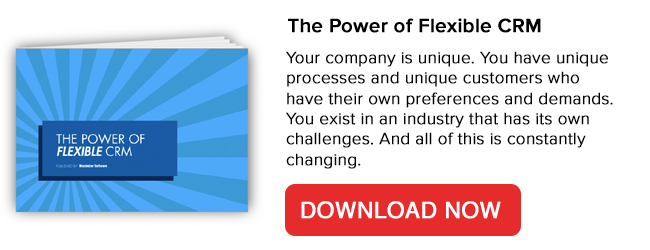 We just finished our first year on HubSpot Enterprise which involved not only adopting new technology but also shifting our entire marketing and sales methodology to embrace the inbound world. Quite a big change!
We just finished our first year on HubSpot Enterprise which involved not only adopting new technology but also shifting our entire marketing and sales methodology to embrace the inbound world. Quite a big change!
During this time we focused on ensuring our sales leaders loved HubSpot as much as we did. Along the way we quickly learned several reasons why your own sales leader will love Inbound Marketing Software.
1) New Leads Actually Want to Talk to Sales
Prior to making the leap to HubSpot we were similar to most organizations – all leads flowed to sales without much context and without ensuring the potential buyer was really sales ready. Leads flowing from the website, online referrals and trade shows were all treated the same. This is clearly not an ideal world for busy account managers.
The greatest gift Marketing can deliver to Sales is a prospect who is ready to talk. As a marketer, there's nothing worse than hearing from a sales rep that a ‘new lead’ was a waste of time. With HubSpot we were able to quickly define the online behavior and characteristics of what made any inbound lead ‘sales ready’. Additionally, by using lead scoring we only sent leads into our CRM that wanted to be engaged by sales.
Why Sales Loves This
Better lead-to-opp conversion rates and increased sales efficiency. Inbound leads have shown buying signals that ensure account managers spend time on leads that have a great probability of converting to an opportunity.
2) More Engaging Sales Conversations
Nothing is more frustrating for a sales person than a ‘prospect’ represented by nothing more than a contact name and telephone number. How do you start that conversation?
As inbound marketers we know there is an entire online prospect journey that takes place online before and after a lead form is submitted. Delivering this journey to your sales team helps them hit the ground running by anticipating a prospect’s needs and areas of interest. An effective salesperson will use these details to craft the perfect conversation and engaging questions to draw out potential business needs.
Why Sales Loves This
More engaging, consultative and effective sales conversations. Easily connect with potential buyers in that first crucial conversation by anticipating what questions to ask and by researching their business in advance.
3) Focusing Sales Efforts on Active Leads
Time for a marketing confession: not every lead I send to sales will buy now – shocking isn’t it? After the initial engaging sales follow up there are a hundred reasons why a prospect might not be ready to move forward. As marketers we will continue to nurture these leads but I also want to enable my sales team to reach out at the right time.
By flagging the specific lead behaviors we can send alerts to sales reps via our CRM. These “follow up now” signals are a click on the pricing page, a return web visit with ten new page views or a recent click-through on a specific marketing message.
Why Sales Loves This
Streamlined lead follow up will help manage leads at different stages of your pipeline. Easily manage large quantities of potential future buyers and pinpoint follow up at the right moment.
4) Effective Nurturing that Helps Close Deals
Prior to a move to Hubspot most businesses have marketing and sales working in different silos. They may have separate marketing software and standalone CRM which are only connected by a dreaded Excel spreadsheet of updated contacts or opportunities. This is definitely a recipe for inaccurate communication to customers and active opportunities.
By connecting HubSpot into your CRM, in our case Maximizer CRM, we extend our marketing efforts into the world of opportunity pipeline nurturing. Needless to say even the best sales organization needs a little help keeping opportunities engaged and getting the right message in front of the person making a purchase decision. We can precisely deliver the right piece of content based on the opportunity stage or type of opportunity.
Why Sales Loves This
Shorter sales cycles and increased close rates. By connecting your CRM (sales opportunities) with Hubspot marketing can take on the responsibility for nurturing and sales can focus on closing deals.
5) Unified Analytics to Remove Doubt
Trying to have an intelligent conversation about lead quality or effective sales follow up cannot be accomplished without connecting marketing and sales. Without this connection winning the sales v. marketing argument usually comes down to who can create the most colorful PowerPoint slides!
The days of debating marketing influence on sales results is over. By connecting Inbound Marketing Software into the CRM there is no hiding from either positive or negative results and alignment around performance can be easily attained. My sales VP can easily view what marketing efforts are delivering more leads and what leads result in more opportunities. This helps rally my marketing /sales team around common objectives and establishes focus on adapting efforts based on visible results.
Why Sales Loves This
Alignment across revenue generated efforts. Focus your efforts on improving sales performance with easily monitored metrics. Once complex reporting is removed from your weekly efforts, revenue results can only improve.
Building excitement around taking your marketing team inbound is easy but making the connection to the realities of the sales world is crucial to amplify success. Most organizations will accomplish this by connecting Inbound Marketing Software into a powerful CRM software solution.
As you begin evaluating Inbound Marketing Software and CRM Software it is crucial to find a solution that can match your unique business. We created an eBook ‘The Power of Flexible CRM’ that helps guide the way with the key characteristics of a flexible solution.

